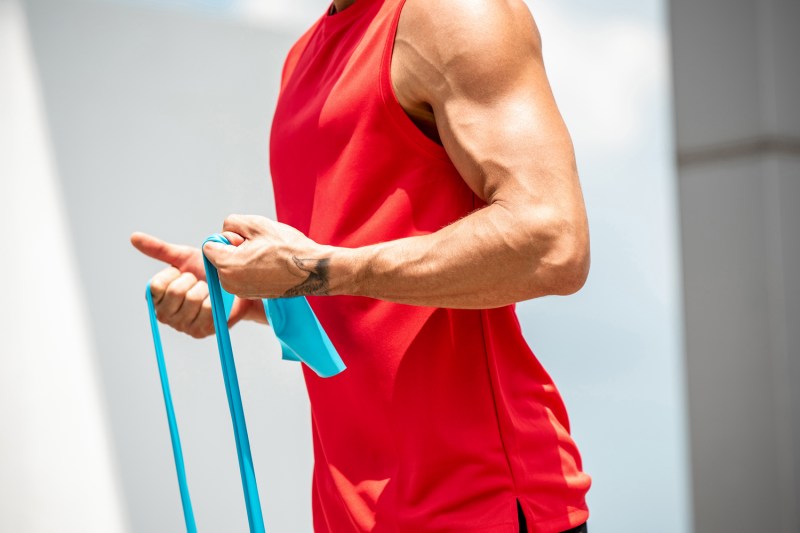Are you excited about your next vacation but worried about messing up your workout routine? While a single vacation won’t ruin the results you have already worked so hard to achieve, I understand the feeling. As a trainer, I always encourage my clients to add resistance bands to their packing lists so they can stay on track.
Keep reading to learn about the many benefits of using resistance bands and why they are the secret to maintaining your workout routine while traveling!
What are resistance bands?

Resistance bands are flexible, stretchable bands that can be used for various tasks, including strength training, rehabilitation, and flexibility exercises. They are quite versatile, as they come in different lengths, widths, and resistance levels, allowing you to adjust the intensity of exercises as needed.
Typically made of latex or non-latex materials, resistance bands can be used for full-body workouts, targeting specific muscle groups throughout the body. They are also portable, lightweight, and affordable, making them a great option whether you are in the privacy of your home, at the gym, or traveling.
There are many benefits of resistance bands, but one of the most notable is how accommodating they are. If you have any joint pain or physical restrictions, resistance bands can be the perfect alternative to traditional weights that may put too much stress on the body.
Why you need to bring resistance bands on your vacations

When going on vacation, many people consider it a break from working out. However, you may be someone who wants to still get some movement in and maintain your current physique, no matter the situation. In my opinion, resistance bands are the perfect solution.
Whether you are staying at a hotel, Airbnb, or somewhere more remote, chances are you won’t have access to the equipment you need. Resistance bands are a good option because they’re lightweight, compact, and easy to pack, taking up very little space in your luggage. You certainly can’t do that with dumbbells!
They’re also versatile, allowing you to perform a variety of exercises to keep your body moving and maintain your current fitness routine. Plus, they’re discreet, so you don’t have to worry about drawing attention or disturbing others if you choose to work out at the beach or in any other public space.
When you’re on vacation, staying active can be a key component to feeling your best, and resistance bands help you do that without the hassle of bulky equipment or needing a special setup. They’re affordable, practical, and an easy way to prioritize your health while enjoying your time away.
Can you get a full-body workout with bands while traveling?

Yes, it can be quite easy to get in an effective full-body workout with resistance bands while traveling. Whether you are using loop bands or bands with handles, they allow you to target all major muscle groups, such as your chest, core, quads, and back.
By adjusting the resistance, you can perform exercises like squats, lunges, chest presses, rows, and ab exercises. Bands provide variable resistance, increasing tension as you stretch them, which helps engage muscles more effectively. In fact, an NIH study found that “Elastic resistance training is able to promote similar strength gains to conventional resistance training, in different population profiles and using diverse protocols.” So, while you may only have your bands while on vacation, they’re still perfect for maintaining strength, flexibility, and endurance.
Tips for staying in shape while traveling

Staying in shape while traveling can be easier than you think with a few simple strategies:
- Plan workouts around your schedule — early mornings or evenings can be ideal for fitting in exercise.
- Use resistance bands or bodyweight exercises for quick, effective routines that require little space or equipment.
- Walk or bike to explore new areas, making sightseeing a part of your fitness.
- Search for outdoor spaces to do simple exercises like squats, lunges, and push-ups.
- Prioritize healthy eating by choosing nutritious snacks and meals.
- Stay hydrated throughout your travels to support your overall health.
Exercises to include in your travel routine

Here are some effective resistance band exercises for your travel routine:
- Squats: Stand with your feet shoulder-width apart and the band under your feet. Hold the handles at your shoulders, squat down by bending your knees, then stand back up, keeping tension on the band.
- Chest press: Secure the band behind you, hold the handles, and press them forward until your arms are fully extended, keeping your elbows slightly bent.
- Lateral walks: Place the band around your legs just above your knees, squat slightly while keeping your back straight, and step side-to-side, maintaining tension in the band.
- Rows: Anchor the band at chest height, hold the handles with your palms facing in, and pull them toward you, squeezing your shoulder blades together.
- Glute bridges: Lie on your back with the band over your hips. Press through your heels to lift your hips toward the ceiling.
Frequently asked questions

Can I bring resistance bands on a plane?
Yes, you can bring resistance bands on a plane in both carry-on and checked luggage. They are not restricted by TSA, but security may inspect them — packing them neatly can help avoid delays.
Can I use resistance bands while sitting?
You can really use resistance bands in any position, so yes, you can use resistance bands while sitting to strengthen your muscles and improve flexibility. Seated exercises include leg presses, seated rows, and bicep curls, and they can be done in nearly any location. Ensure proper posture and controlled movements for the best results and to prevent injuries.
Is it OK to use resistance bands every day?
Using resistance bands every day can be beneficial if done properly. However, it’s important to allow muscles time to recover, so alternate muscle groups or vary exercises to avoid overuse and reduce the risk of injury. Listen to your body and incorporate rest days for optimal results and recovery.




